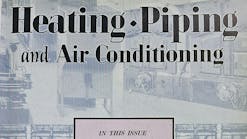As an engineer, I appreciate our obligation to specify building systems that enhance the health and welfare of people in the structures we design. But I’m not just an engineer, as over the past decade I’ve been actively involved with mitigating legionella risks through tankless water heater design.
Last spring there was an outbreak of Legionnaires’ disease in the Bronx area of New York City involving dozens of people being diagnosed with the disease, and most sadly, several fatalities. It was this horrible outbreak that provided me the inspiration to share this guidance.
This information is not intended to scare you about legionella – there’s plenty of other content in the news with that intent. Rather we want to provide some background about legionella and how it can multiply, together with tips for how plumbing engineers can recommend systems that help mitigate its risk.
Size and Scope of the Problem
There are around 6,000 reported cases of Legionnaires' disease each year in the United States, according to OSHA. Scientists believe the actual number of cases is much higher, given the difficulty in distinguishing Legionnaires' disease from other types of pneumonia. The most recent U.S. population-based study estimated that 8,000-18,000 people are hospitalized each year with Legionnaires' disease.
- For more on Legionella, listen to our latest episode of HPAC On The Air, here.
Yet recent data on legionella outbreaks have suffered under the Covid pandemic. Fewer people are getting tested for legionella because most testing is focused on Covid. In this compromised testing environment, it appears to take a multi-person outbreak in a specific area before legionella is considered a suspect.
While testing numbers are down, the good news is that there has been an advance in legionella detection. Clinicians now use a urinary antigen test, which detects L. pneumophila serogroup 1, one of many organisms that cause the disease, and the one responsible for more than 70% of the reported cases. This testing approach is now available and widely used throughout the U.S.
Legionella and Potential Growth
The legionella organism lives and proliferates in temperatures between 68° and 122° F. In temperatures below 68° it doesn’t die; it simply goes dormant and is less likely to replicate. Additionally, the organism can survive at 122° for eight hours and doesn’t instantly die until temperatures reach 176° degrees. Clearly this organism is tough and can thrive in many common plumbing systems, including stratified hot water storage tanks.
Plenty has been written about the most common breeding pools for legionella: cooling towers; spas/hot tubs; fountains and similar water features, but there’s been an absence of information available about legionella and domestic use water systems, so we’ll focus on this specific area. Plumbing engineers are responsible to provide safe, easy-to-implement plans for contractors to follow, creating healthy built environments.
There are three primary conditions required for legionella growth:
- low water temperature (that is, somewhere between 68° and 122° F)
- stagnant water
- presence of biofilm
Clearly these conditions exist in many modern plumbing systems, so let’s examine each of these risks.
Water Temperature
The water in a typical hot water storage tank is stratified by temperature – some of which is inhospitable to legionella, but there are frequently pockets of temperatures that are more friendly to the organism.
Depending on the facility or application, the required hot water temperatures will differ. A sink in a hotel room might be limited to 120°, while a laundry facility or restaurants might need 130° or higher. Engineers often solve this issue with mixing valves, but mixing valves are mechanical devices, and are therefore prone to problems that can lead to water being too hot or too cold. Additionally, mixing valves mess with the system equilibrium and may create risk pockets of stagnate water due to oversized piping, dead piping, or poorly balanced systems. It’s like the human circulatory system - if you have a clogged artery, it creates problems for the entire body, not just for a particular area.
Water Quality and Movement
Water quality in a storage tank is rarely uniform either, with sediment of various types gathering at the bottom of the tank. This sediment is often both a food and insulator for organisms. So, all it takes is for a disruptive event to the tank – for example, water hammer or fire hydrant use nearby – for the tank to stir and create a situation more favorable for legionella.
Additionally, to meet the requirements of building owners, many plumbing engineers oversize hot water systems to address peak-demand situations when by chance everyone demands hot water at the same time. Some even add a backup hot water storage tank for insurance. And it’s this stored (stagnant) water which invites legionella. Aside from legionella, oversized hot water systems also create efficiency and maintenance problems.
Biofilm
Biofilm is simply a polymeric solution that is excreted from certain organisms. It forms a protective and adherent substrate, is a great insulating factor, and is also a food source, making it a popular breeding ground for bacteria.
As an insulator, biofilm can exacerbate the stratification in a hot water storage tank, making some areas even more attractive for legionella. Biofilms can even grow in high velocity situations where lots of water moves across a surface.
Legionella does not produce biofilm directly, but it does feed on it.
How To Reduce Risk
To prevent Legionnaires’ disease, it’s imperative to reduce the risk of legionella growth and transmission in water systems. We can achieve this by making sure building water systems are clean and well-maintained, while monitoring water regularly for legionella bacteria.
Modern technology also plays a key role in the mitigation of legionella growth, particularly when it comes to the selection of water heaters. A decade or two ago, commercially-sized tankless heaters were not available, or were not up to the task. But times have changed and there are great commercial tankless options available for plumbing engineers now.
While tankless technology does not eliminate all legionella risk, it does significantly mitigate it by creating a less hospitable environment for legionella, which is achieved in multiple ways:
- With no stored water, we eliminate the bacteria, sediment, and bio-film risks found in stagnant water. Reducing or eliminating these impurities is key to success;
- Tankless units maintain a consistent output water temperature without any additional controls in place, eliminating mechanical points of failure found in mixing valves. This consistent water temperature eliminates the stratification of water, with its resulting pockets of attractive temperatures for legionella. Creating temperatures that are inhospitable to legionella is key to removing its risks;
- Finally, tankless units use advanced flow control, which keeps the water moving rather than storing it in stagnant tanks. Legionella cannot thrive in moving water.
Healthcare, hotels, multifamily housing units, and senior living centers are particularly attuned to mitigating legionella risks, and these industries have exponentially increased their use of tankless water heaters.
Today, many resources are available to assist plumbing engineers as they work to reduce legionella risk. We recommend visiting our legionella resource center for more information, and to review our case studies to see specific examples of how other engineers have used tankless water heaters to help mitigate legionella risks while gaining cost efficiencies and carbon reductions.
About the Author
Sridhar (Sri) Deivasigamani is the founder and CEO of Intellihot, a designer and manufacturer of built-environment systems based in Galesburg IL. He holds a bachelor’s degree from Manipal Institute of Technology, India, and a master’s degree in Mechanical Engineering from Clemson University. Mr. Deivasigamani has earned more than 60 patents, is a member of the International WELL Building Institute (IWBI) Health Equity Advisory Committee, and is a 2022 Edison Award winner for Software Innovation. For more, visit www.intellihot.com.









